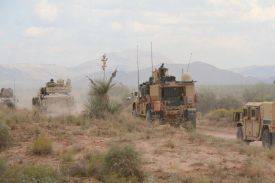
FORT BLISS, Texas (May 12, 2016) — During battlefield operations, a brigade’s fleet of Warfighter Information Network-Tactical (WIN-T) network equipped vehicles are often spread out across great distances and austere terrain, supporting both stationary command posts and on-the-move missions. Newly enhanced and simplified Network Operations (NetOps) tools will make it easier for communications officers (S6s/G6s) to see the “big picture” as they plan, manage and defend the vast tactical mission command network, increasing its security and strength.
“In a battlefield environment where everything is transferring over the network and cyber security is a constant concern, NetOps is absolutely critical,” said Col. Charles J. Masaracchia, commander for 2nd Brigade, 1st Armored Division (2/1 AD), the main operational unit for the Army’s Network Integration Evaluations (NIEs). “With these tools we have the ability to see the network and identify and fix anomalies; we can identify a problem with a node and start troubleshooting from right here [at the brigade command post] and sometimes even fix it without ever having to go to the distant station. That’s incredible.”
Simplifying the Network, Reducing the Burden
The Army has been testing the new NetOps software upgrades this month as part of the WIN-T Increment 3 Limited User Test, conducted at NIE 16.2 at Fort Bliss, Texas. Successful evaluation results will support the software technical insertion of the new enhancements into both the at-the-halt and on-the-move increments of the WIN-T network, which is currently projected for fiscal year 2017. Feedback gained from the evaluation will also support future network improvements.
During the NIE’s complex decisive action exercises, the brigade’s S6 and his network staff used the improved NetOps tool suite for a wide array of tasks, including configuring, operating, monitoring and troubleshooting the network, as well as defending it against continual cyber attacks. The new enhancements automate many of these functions to make it easier for the network team to manage the network and be more effective.
“The enhanced NetOps tools will allow the S6 to better fight the network in parallel with the battle,” said Col. Ward Roberts, product manager for WIN-T Increment 3. “Through the visualization tools and their integration with network devices, the S6 can now adjust the network design to better meet the commander’s intent as the battle evolves.”
The Army continues to listen to Soldier feedback from theater, user juries and test events to make WIN-T NetOps, user interfaces and network systems more intuitive, easier to operate, with a consistent look and feel. Significant simplicity improvements evaluated at NIE 16.2 include enhancements to the NetOps planning, monitoring and troubleshooting tools.
“These NetOps software enhancements are much more intuitive to the Soldier and are much easier to use,” said Staff Sgt. Nicholas Vettore, 2/1 AD assistant network technician and senior satellite communication systems operator. “With this quick responding software, almost any user who has had a small amount of training will be able to use it and provide the commander with critical summary reports in minutes versus hours as it had been in the past, which could [potentially] save lives and makes mission success much easier [to obtain].”
As part of the WIN-T Increment 3 testing during NIE 16.2, the Army also evaluated the next generation of Network Centric Waveform (NCW) software, v10, which makes the network more robust. NCW enables beyond-line-of-sight (satellite) communications from division headquarters down to the company level. The NCW v10 software enhancements provide efficiencies through software coding, resulting in four times higher throughput without changing any hardware. That equates to more bandwidth available for the user with much less overhead from the network.
“The increased throughput enables the mission command network to absorb more traffic from intelligence, medical and logistics networks,” Roberts said. “Now we can provide throughput for all of those areas without needing extra antennas, satellites, and bandwidth. So bandwidth can be available to push full motion video, for instance, while still allowing the mission command traffic to flow through smoothly.”
The new WIN-T enhancements also provide better firewall tools and defensive cyber visualization to help signal Soldiers more easily manage, protect, and harden the network from vulnerabilities. During NIE 16.2 the enemy red team posed a very robust insider cyber threat to fully stress the systems and flush out any weak points, Roberts said.
One of these mechanisms, Public Key Infrastructure (PKI), provides network resiliency and an additional layer of security by supporting the distribution and identification of public encryption keys. PKI enables stronger authentication of identity for users and devices on the network. It also reduces system complexity by reducing the number of passwords needed to manage the network.
Vettore, who has supported seven NIEs and multiple focus groups, said he has witnessed the NetOps improvements first hand.
“I am seeing the changes from recommendations that we put out two years ago actually being built into the software,” Vettore said. “They take it seriously; they don’t just write it down and then never follow up on it; they put the time in, they put the work in, they realize that ‘yes’ it is helpful to get our feedback. “
The Army is also working to improve the NetOps of the lower tactical internet (TI) radio network through the newly enhanced Joint Enterprise Network Manager (JENM), the Army’s Joint radio network manager. Looking forward, the Army plans to continue efforts to further synchronize the WIN-T and radio networks to better unify how it is managed and fought.
“Through a synced upper and lower TI, you can get a general or a very detailed overview of the network,” Vettore said. “Here at the brigade level we can monitor the health of the network and troubleshoot down at the furthest levels; and we are also able to prioritize where a major mission should take place. Being able to control the network from a top to bottom is extremely important.”


